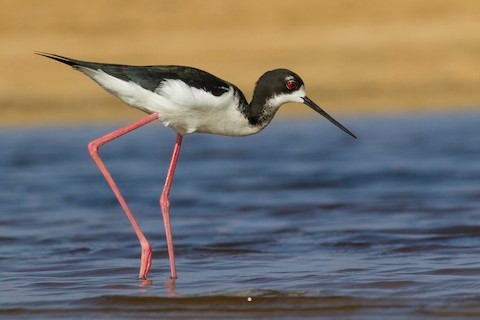Recurvirostridae: Stilts
The stilts are a small family of large shorebirds with very long, stilt-like legs. They thrive in shallow ponds, bays, and marshes, mostly in warm climates where they are sedentary, tropical counterparts to the migratory tringine sandpipers that winter with them.
The family includes two distinct groups, stilts and avocets, which differ most prominently in bill structure. Stilts have straight, needle-like bills, whereas avocets have upcurved bills that are well-suited for a certain approach to foraging: sweeping through loose silt for prey.
Stilts have a nearly global distribution throughout the tropics and warm temperate zones. Avocets are also present on all the inhabitable continents but are evidently limited to breeding in habitats that favor their specialized foraging style.
Taxonomy
The genus Himantopus is notoriously difficult to resolve at the species level, and has been regarded as comprising anywhere from one to six species. In the 2000s, the lower limit has been two, as the critically endangered Black Stilt (H. novaezelandiae) of New Zealand is almost universally accepted as a separate species. Conversely, the Hawaiian form knudseni is generally recognized as a distinctive subspecies of the continental Black-necked Stilt (H. mexicanus) whose isolation is too recent for it to be regarded as a separate species.
Three controversies remain: two that seem straightforward and one more challenging. First, do Old World and New World stilts comprise a single cosmopolitan species? Some global taxonomic authorities maintain this view, but it seems unlikely to persist against the long-term trend toward recognizing more species diversity. Second, within the Old World, the same authorities regard the Australasian Pied Stilt (H. leucocephalus) as a subspecies of the widespread Black-winged Stilt (H. himantopus), although these forms do not appear to overlap either visibly or reproductively.
Finally, in South America the northern Black-necked and southern White-backed Stilt (H. melanurus) reportedly interbreed and intergrade with one another in Peru and possibly also in Brazil. The vocalizations seem to differ consistently and most individuals are assignable to one or the other, so provisional recognition as separate species seems justified—but with a caveat that further study of breeding populations could conceivably yield evidence that they function as a single species.
Pending a clearer resolution of the relationships among the New World stilts, the Recurvirostridae thereby comprise between 9 and 11 species.
Black-winged Stilt (Himantopus himantopus)
Pied Stilt (Himantopus leucocephalus)
Black-necked Stilt (Himantopus mexicanus)
“Hawaiian Stilt” (H. m. knudseni)
“Black-necked Stilt” (H. m. mexicanus)
White-backed Stilt (Himantopus melanurus)
Black Stilt (Himantopus novaezelandiae)
Banded Stilt (Cladorhynchus leucocephalus)
Pied Avocet (Recurvirostra avosetta)
American Avocet (Recurvirostra americana)
Red-necked Avocet (Recurvirostra novaehollandiae)
Andean Avocet (Recurvirostra andina)
References
Boyd, J.H., 2019. Taxonomy in Flux: Gruae II: Charadriiformes. http://jboyd.net/Taxo/List9a.html. (Posted August 2, 2019. Accessed October 14, 2020.)
Hayman, P., J. Marchant, and T. Prater. 2009. Shorebirds: An Identification Guide. Houghton Mifflin, Boston.
Roberson, D. 2016. Bird Families of the World: Stilts & Avocets, Recurvirostridae. http://creagrus.home.montereybay.com/stilts.html. (Posted November 7, 2016. Accessed October 14, 2020.)
